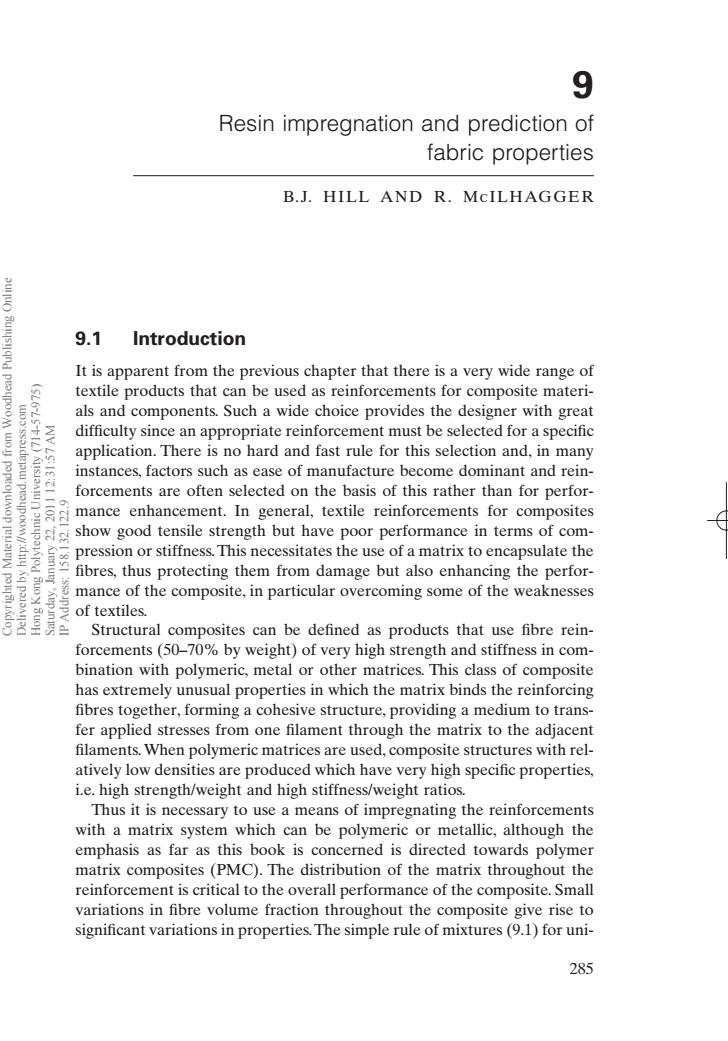正在加载图片...

9 Resin impregnation and prediction of fabric properties B.J.HILL AND R.MCILHAGGER 9.1 Introduction It is apparent from the previous chapter that there is a very wide range of textile products that can be used as reinforcements for composite materi- als and components.Such a wide choice provides the designer with great difficulty since an appropriate reinforcement must be selected for a specific application.There is no hard and fast rule for this selection and,in many instances,factors such as ease of manufacture become dominant and rein- 2102 forcements are often selected on the basis of this rather than for perfor- mance enhancement.In general,textile reinforcements for composites show good tensile strength but have poor performance in terms of com- pression or stiffness.This necessitates the use of a matrix to encapsulate the fibres,thus protecting them from damage but also enhancing the perfor- 豆 mance of the composite,in particular overcoming some of the weaknesses of textiles. 8 Structural composites can be defined as products that use fibre rein- forcements(50-70%by weight)of very high strength and stiffness in com- bination with polymeric,metal or other matrices.This class of composite has extremely unusual properties in which the matrix binds the reinforcing fibres together,forming a cohesive structure,providing a medium to trans- fer applied stresses from one filament through the matrix to the adjacent filaments.When polymeric matrices are used,composite structures with rel- atively low densities are produced which have very high specific properties, i.e.high strength/weight and high stiffness/weight ratios. Thus it is necessary to use a means of impregnating the reinforcements with a matrix system which can be polymeric or metallic,although the emphasis as far as this book is concerned is directed towards polymer matrix composites (PMC).The distribution of the matrix throughout the reinforcement is critical to the overall performance of the composite.Small variations in fibre volume fraction throughout the composite give rise to significant variations in properties.The simple rule of mixtures(9.1)for uni- 2859.1 Introduction It is apparent from the previous chapter that there is a very wide range of textile products that can be used as reinforcements for composite materials and components. Such a wide choice provides the designer with great difficulty since an appropriate reinforcement must be selected for a specific application. There is no hard and fast rule for this selection and, in many instances, factors such as ease of manufacture become dominant and reinforcements are often selected on the basis of this rather than for performance enhancement. In general, textile reinforcements for composites show good tensile strength but have poor performance in terms of compression or stiffness. This necessitates the use of a matrix to encapsulate the fibres, thus protecting them from damage but also enhancing the performance of the composite, in particular overcoming some of the weaknesses of textiles. Structural composites can be defined as products that use fibre reinforcements (50–70% by weight) of very high strength and stiffness in combination with polymeric, metal or other matrices. This class of composite has extremely unusual properties in which the matrix binds the reinforcing fibres together, forming a cohesive structure, providing a medium to transfer applied stresses from one filament through the matrix to the adjacent filaments.When polymeric matrices are used, composite structures with relatively low densities are produced which have very high specific properties, i.e. high strength/weight and high stiffness/weight ratios. Thus it is necessary to use a means of impregnating the reinforcements with a matrix system which can be polymeric or metallic, although the emphasis as far as this book is concerned is directed towards polymer matrix composites (PMC). The distribution of the matrix throughout the reinforcement is critical to the overall performance of the composite. Small variations in fibre volume fraction throughout the composite give rise to significant variations in properties.The simple rule of mixtures (9.1) for uni- 9 Resin impregnation and prediction of fabric properties B.J. HILL AND R. McILHAGGER 285 RIC9 7/10/99 8:32 PM Page 285 Copyrighted Material downloaded from Woodhead Publishing Online Delivered by http://woodhead.metapress.com Hong Kong Polytechnic University (714-57-975) Saturday, January 22, 2011 12:31:57 AM IP Address: 158.132.122.9